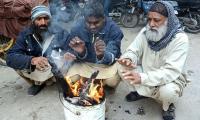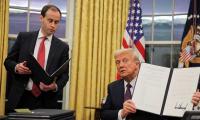It has been two weeks since Zainab Ansari’s dead body was found in Kasur. The news that a seven-year-old child could be raped and murdered, in a city that had already endured a massive child pornography ring reported on in 2015, was shocking. Protests ensued in Kasur; anger, and rage around the rest of the country. #JusticeforZainab was the hashtag. Within twenty-four hours of Zainab’s body being found, other cases of sexual assault, rape and murder of children began to emerge.
The Punjab government, which prides itself on responsiveness and use of technology, can build new metro lines in a matter of months, but cannot find and punish the child pornographers and rapists of Kasur. It is an outrage. There are no quick fixes for the kinds of problems that produce the vulnerability of children like Zainab, but there are some easy and obvious things that Chief Minister Shahbaz Sharif can start with.
There is now so much reportage on a PML-N MPA’s alleged role in helping free suspects in the 2015 child rape and pornography ring, that continuing to ignore it indicates an unwillingness to genuinely create a safer environment for the children of the Punjab. An independent inquiry commission that is not headed by people belonging to the sitting government must be formed to explore why the 2015 case did not produce safety for Kasur’s children.
Of course, the scalp of one MPA is not a material gain in the struggle to reform state and society. But any MPA that is able to survive his or her active engagement in abetting crimes of this nature only indicates an embrace of the moral collapse that many already accuse Pakistani democracy of. Digging into why the 2015 Kasur case did not produce more robust and longer-lasting protection for children is the very minimum that the Punjab government owes its children.
Columnists have pointed out that, while the federal government, the provincial governments and even the judiciary have all been making progress on addressing child sexual abuse and exploitation in a variety of ways, a mountain of work needs to be done to address the wide array of challenges this problem poses.
The Punjab government has constituted a Committee on Safeguarding Children (full disclosure: I was included on this committee, though have yet been unable to attend its several meetings since last week). This committee has produced three sub-committees, one to work on the adoption of an ‘amber’ alert system that helps identify and find victims quickly, a second that examines the need for changes to existing legal and criminal procedures, and a third that is supposed to examine school curricula and ways and means for wider societal awareness about child sexual abuse and exploitation.
All of these quick measures are important and they reflect the sincerity of purpose that exists among the many senior officials in Punjab, including the chief minister, that want to make things better. This is the good news.
The bad news is that none of these measures can address the white, hot core of the problem. Children like Zainab in Kasur, and Asma in Mardan are not vulnerable because of the system failed. They are vulnerable because the existing system works. The vulnerability of Pakistani children is hardwired into state and society. No matter how many notices the chief minister of a province takes, no matter how many suo-motu cases the chief justice initiates, and no matter how many tickers, updates and tweets such outrages generate, the grand compact that is the basis for our day to day, year to year, and decade to decade existence includes a proactive disregard for children. This cannot be solved with any of the tools that are available to Pakistan today. Not with Punjab speed, nor with a justice tsunami, nor indeed with a gaggle of retired technocratic uncles, or angry three and four-star officers. Tackling the crisis of Pakistani children requires an examination of the fundamentals of state and society. If we keep misdiagnosing our problems, we will keep failing to solve them.
Every urban area in the country teems with child labour, child beggars, street children, out-of-school children, and dropouts. Where have these children come from? From parents for whom reproductive rights are almost entirely contingent on the fertility of the male partner. Female agency in the reproductive process is, despite huge advances in addressing the balance of power between genders, extremely limited – especially as we proceed down the totem pole of wealth, income and consumption.
It is hard to ascertain exactly what quantum of unsafe and unreported abortions take place in Pakistan every day. Many people who read English newspapers, regardless of their disposition in terms of social values, would be shocked to speak to doctors in cheap, makeshift private medical facilities across the country. Specialists in the field of reproductive health are anxious about engaging in a public dialogue about the problem, because it would require acknowledging the existence of two substantial realities: married women who simply do not want to continue their pregnancies, and unmarried women who cannot, regardless of their own sentiments, continue their pregnancies. Both represent challenges to discourse in a country where public policy must be, both constitutionally, and politically, consistent with broad notions of religious virtue. To tackle this requires leadership that is not so much bold as it is willing to plan and execute a course of action that satisfies the moral and ethical demands of safety and security for women and children as well as the constitutional and political demands of Islamic values.
Complicated pregnancies, no matter how prevalent, represent a small fraction of the cohort of children conceived every day in Pakistan. Upon conception, what kind of treatment do we mete out to them? Maternal nutritional health, which begins to affect the cognitive capacity of an embryo by the third month of gestation, is second nature to the well-off, but an oddity among those less fortunate. Malnutrition statistics in Pakistan tell the story better than any amalgam of words can. According to the 2011 National Nutrition Survey, a quarter of all children below five years of age are severely stunted (low height for their age), 17 percent of all children suffer from wasting (low weight for their age), and 31 percent of all children are underweight for their age. The resultant cognitive challenges should not be difficult to predict. Pakistani children score poorly in every measure of learning outcomes, at every level.
These disadvantages are hardwired into the analysis before we even begin to engage with child safety in the context of school enrolment, school to home distances, teachers’ awareness and accountability, and child safety in the home, especially in large, joint family households.
To address this requires a conversation about how society is organised and why the state exists. If the purpose of a society is to worship the rich and the purpose of the state is to fight anyone that questions it, then there is nothing wrong with Pakistan. If the purpose of a society is to protect the weak and vulnerable and to create a brighter future, and the purpose of the state is to fuel such a future, then much work needs to be done.
Until there is a critical mass of Pakistanis that insist on a rethink and reform of the fundamentals of this country, Pakistan’s elite – civilian, military, religious and sundry – will continue to jump from one crisis to the next, sometimes deliberately obfuscating the issues, sometimes genuinely failing to tackle them. We can either follow them into each rabbit hole, coming up empty every time, or we can stand our ground and demand a rethink and reform of the fundamentals. We are not powerless consumers of the stupidity of the elite. We can do better. For ourselves and for every child in this country.
The writer is an analyst and commentator.
Disturbances that began in 2023 with attack on school have escalated rapidly in recent weeks
Obvious ineptness and lack of empathy that underpins our criminal justice system need not be recounted
Women constitute about 22.63% of formal labor force, while men make up 84.79%
Responsibility falls on Global North to address issues facing Global South before it collapses entirely
FAO recognises home gardening as crucial strategy to enhance household food security and nutrition, particularly in...
Pakistan’s judicial system has evolved in a complex manner since country’s inception







